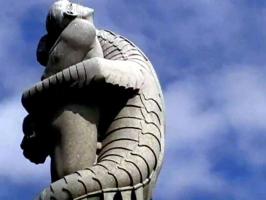The occult history of space travel
Astronautics is a human activity of recent creation, yet in almost 60 years the enigmas surrounding space missions are countless, as are the tragedies.

On April 12, 1961, Humanity officially entered the Space Age with the launch of the first astronaut into orbit, the Soviet Yuri Gagarin. A space history marked by various successes and nationalist pride, but also by dreadful tragedies. And mysteries, many, many mysteries. In nearly sixty years, space travel has given us so many unknowns that we practically know nothing about what really happened in Earth's orbit. Starting with Gagarin: it is unknown whether he was truly the first man in space or if, as many claim, there were other astronauts deserving of fame, with the "only fault" of having perished upon returning to Earth.
To be honest, the first living being to go into orbit was the dog Laika, perhaps the world's most famous dog after "Lassie." Idolized by millions of children, she was launched into orbit by Soviet technicians with the Sputnik 2 satellite on November 3, 1957, just a month after the first true space mission of Sputnik 1.
However, Laika's space journey was quite improvised, carried out at the request (or more accurately, the whim) of Soviet Premier Nikita Khrushchev to celebrate the fortieth anniversary of the October Revolution. The Russian engineers were caught off guard and, in a completely makeshift manner, within a few days, they locked themselves in the workshop to modify the already-built Sputnik 2 capsule, which was not designed to host living beings, using bolts and a blowtorch.

In a cramped and suffocating space, the designers managed to install a survival and temperature regulation system equipped with a pressurization unit, a datalink for transmitting vital parameters, and even a food dispensing apparatus. They still needed a test subject for the launch, which would reveal to the world if living beings could survive in space.
Several dogs were rounded up from the streets of Moscow, and the choice fell on a three-year-old female, a mixed breed between a Husky and a Terrier, who was named Laika. The dog was medium-sized and very docile: her incredible patience allowed her to be selected for the mission. Laika endured the harnessing process, which lasted five days; a kind of spacesuit bound her to the capsule, with no possibility of moving her legs or body.
Sputnik 2 was hoisted onto the launch rocket, and Laika endured another three days of complete immobility, with her feces and urine collected in a special bag.
Then the launch: the animal's heart rate reached 250 beats per minute, on the brink of a heart attack. Laika didn't know what the humans were doing to her. The journey, aside from the sheer terror, proceeded without issues until reaching orbit. Here, Laika calmed down a bit and was heard eating the special gelatinous food. However, this was her last act: after five hours in orbit, the temperature regulation system broke down, and the capsule's temperature shot up from 18 degrees to 41 degrees. Laika whimpered in pain, her labored breaths were heard until she collapsed. It is unclear if she died at that moment due to euthanasia, administered by a poison injection from the Soviet control center, but it hardly matters, because Sputnik 2 would re-enter the atmosphere and disintegrate like a meteor.
Naturally, the Soviets kept silent about all the atrocities committed, although animal rights groups, already active in 1957, began protesting in front of Russian embassies in all Western countries.

The fact is that the scientists and technicians involved in the mission were shocked and, years later, revealed many details indicative of the shroud of mystery surrounding the early space missions. For example, Dimitri Malashenkov said that the euthanasia story was a compassionate lie; Russian writer Anatoly Zak stated in his book that Laika's agony lasted for the four days of the mission. One of Laika's trainers, Oleg Gazenko, said some time ago that the greatest regret was that Laika's sacrifice was in vain: not enough was learned from her physiological data because it was distorted by the heat, and this is the worst certainty of all the "space vivisection."
Nevertheless, the Russians continued the practice of sending stray dogs into space, creating two-seat capsules to evaluate social interactions between the two animals on board: some of them were recovered (miraculously, one might say)... Thousands of animals, dogs, monkeys, frogs, mice, were sent into orbit in those years; some returned to Earth, only to be meticulously dissected in laboratories in search of phantom diseases, while others burned up, spared from subsequent torture.
But such an atrocious fate also befell some human beings.
This is what two brothers from Turin (Italy), originally from Brianza, Gianbattista and Achille Judica Cordiglia, claimed in the 1960s. As avid amateur radio enthusiasts, the two brothers built a special antenna mounted on a tower near Turin in the mid-1950s, allowing them to pick up space communications. Towards the end of the decade, and before Gagarin's launch, they intercepted radio transmissions from the first Russian probes (including the first artificial satellite, Sputnik 1) and also strange data. Turin was a privileged location in this sense, the first point where Soviet spaceships reconnected with bases in Russia after the communication blackout imposed by flying over the United States.
"We caught Gagarin's voice and announced the presence of the first man in space a few minutes before Tass officially did,"
Gianbattista Judica Cordiglia recounts in one of the books written with his brother.
"However, before him, there were attempts that went unreported. The first mission was on November 28, 1960. The message intercepted in Morse code was a chilling appeal: 'SOS to the whole world' repeated obsessively. The signal came from a fixed point in the sky and grew increasingly weaker. In the end, we were convinced that a spaceship was getting lost in space with its occupant. We detected a second flight on February 2, 1961: the recording distinctly captures the dying gasps of a cosmonaut and his heartbeat. Two days later, the USSR announced the launch of Sputnik 7, a 6.5-ton vehicle: practically the same characteristics as a Vostok spacecraft, like the one Gagarin would use. Along with the launch, Moscow also reported its disintegration upon re-entry into the atmosphere. There was no mention of the fate of the cosmonaut we had intercepted, but Achille Mario Dogliotti, one of Italy's leading heart surgeons, studied our recordings and confirmed that it was a human heartbeat. In May 1961, we recorded the live death of a crew: two men and a woman. The woman's message is a punch to the gut. Her two colleagues were probably already dead, and the cosmonaut was seeking help from the base: the re-entry maneuver was out of control. The voice obsessively repeated numbers, then 'I'm hot, I'm hot, I'm hot' and 'The world will not know this'."

The account of the Cordiglia brothers is shocking and stirred the anger of Soviet generals and bureaucrats. From the USSR, threats of all kinds rained down on these two "enemies of the Revolution," which was understandable given the Soviet regime's emphasis on secrecy at all costs as an essential element of its propaganda exaltation that "everything was working perfectly." However, from an objective standpoint, expert observers, including from NASA, said that their claim made no sense: the data, both biometric and radio, were always encrypted in a binary telemetry code that was decoded on the ground. It was impossible for two amateur radio operators to intercept heartbeats, labored breaths, or even words and SOS signals: they would have needed the decryption code! For this reason, the matter quickly fell into oblivion, but doubts about Russian space missions remained.
On April 10, 1961, just before Gagarin's flight, the Moscow correspondent for the British Communist Party's Daily Worker newspaper, Dennis Ogden, surprisingly announced in his report that a man had been launched into space but had returned disfigured and had been hidden in a nursing home. The pilot was indirectly identified as Lieutenant Colonel Vladimir Sergeyevich Ilyushin, the son of aircraft designer Ilyushin and a famous test pilot. The cosmonaut, launched on April 7 or 8, had orbited the Earth three times in his spacecraft "Rossiya."
The announcement caused shock, especially among the Soviets: as mentioned, on April 12, the spacecraft "Vostok 1" orbited the Earth and landed. However, the spacecraft's orbit immediately raised doubts. Launched from Baikonur in Kazakhstan, with an inclination of 65°, the ship flew over Siberia, the South Pacific, northern South America, Africa, and landed in southeastern European Russia: it was not possible that Gagarin could have flown over that area of South America as stated.

Another problem was the landing. The Vostok 1 had an ejection seat that the pilot could use as an emergency escape means during descent; Gagarin ejected during the final phase of descent and landed separately with his own parachute. Presumably, the main parachute of the 3,000 kg capsule would not have reached a descent speed low enough to allow for a comfortable level of impact. But doubts about a possible prior flight remained because it seemed that the main problem was indeed the impact with the ground: previous negative experiences could have led Gagarin and the Control Center to choose the ejection seat solution. The solution was probably very safe because Gagarin's flight seemed perfectly organized from the start, with bronze busts already prepared, posters printed, and awards and honors prearranged. And this made it seriously doubtful that Gagarin had actually made the flight.
Theories about pre-Gagarin space flights thus resurfaced and were well summarized in an article by journalist James Mills, published in the June 1961 issue of "True Magazine." Of particular interest is the description of a launch that took place on February 4, 1961, coinciding with the one described by the Judica Cordiglia brothers. The pilot in question was named Gennady Mikhailov and perished, like Laika, burning alive in the atmosphere...

Nevertheless, even Gagarin, caught up in controversy, met a mysterious end: according to the official version, he died on March 27, 1968, killed in his two-seater MiG-15 during an experimental flight. But anyone with even a basic knowledge of aviation knows that the MiG-15 was already an outdated aircraft by 1968: it dated back to the late 1940s and was one of the key players in the Korean War from 1950 to 1953. Considering the two-seater MiG-15 (identified by the UTI designation, indicative of trainers) an advanced aircraft worthy of a cosmonaut is truly absurd! Some pilots recount how Gagarin was deliberately made to fly that small plane and then "struck" by the shockwave of a highly advanced fighter, the MiG-25, capable of flying three times the speed of sound. An orchestrated accident to eliminate an inconvenient witness, as many opponents of the former Soviet Union suggest? And what about the portrayal of Gagarin as an alcoholic? We don't know the truth, and we want to remember Yuri as a great pilot and flight enthusiast who had the privilege of flying in space... The rest is propaganda talk.
Indeed, beyond the Iron Curtain, in the United States, transparency did not prevent unusual accidents such as the Apollo AS-204 incident. The space mission ended before it began: on January 27, 1967, astronauts Virgil Grissom, Edward White, and Roger Chaffee perished on the launch pad in a fire aboard the Apollo 1 capsule caused by a short circuit. The pure oxygen was ignited by a spark and consumed the bodies of the three men within 15 seconds, trapped inside the lunar module on the platform. It was a routine test, but the accident revealed such a series of problems that it cast doubt on NASA's ability to resolve them in time for the moon landing in 1969. We have already discussed the doctored photos from NASA in this context: to this day, we do not know if man actually went to the natural satellite due to the numerous doubts.

Apollo 1 might have been the wake-up call for the technical impossibility of undertaking space travel. Even the famous Apollo 13 mission, celebrated in films and documentaries, is considered by some to be just another attempt to actually reach the Moon, which was not crowned with success. Essentially, the most extreme theories claim that Apollo 11 never touched the lunar surface, nor did Apollo 12; Apollo 13, on the other hand, had a functioning LEM module, but the Van Allen Belts' electrical field supposedly destroyed an oxygen tank, preventing the first actual mission. Others, especially among the more conspiratorial ufologists, assert that Apollo 13 carried a nuclear bomb intended to be used against a hypothetical alien base, but in our view, this falls into the realm of science fiction (or paranoia, depending on one's perspective).
The fact remains that man did not stay on the Moon, and the only evidence of his presence is several hundred kilograms of lunar rocks, which can also be obtained through unmanned probes! It is important to emphasize that space flight is no joke and that every mission can have a fatal unknown.
NASA knows a thing or two about this, having lost two out of five Space Shuttles in thirty years. The first tragedy, which struck the Challenger shuttle, occurred on January 28, 1986. Due to a series of unfortunate events and design errors, combined with record cold temperatures for sunny Florida, an auxiliary rocket experienced a failure in a rubber seal, causing a fuel leak that led to the explosion of the main tank 73 seconds after launch. The structural failure also impacted the so-called Orbiter, the actual shuttle, which broke into thousands of fragments. Of the seven crew members, four remained alive for a long time, and at least three were conscious enough to activate emergency devices, but it was in vain as their trajectory ended against the surface of the sea, impacting at 337 km/h with a deceleration of 200G, enough to cause death. However, the true causes of the crew's demise have never been clarified, as highlighted in NASA's final report (available at https://www.nasa.gov/missions/space-shuttle/sts-51l/challenger-crew-report/).

Two years later, in 1988, the space missions of the SSTS shuttles resumed with Discovery, and for over fifteen years it seemed that the system had completely resolved its issues, although there were incidents, but they concluded without consequences. However, like a cold shower, on February 1, 2003, a long series of streaks crossed the American skies: it was what remained of the Columbia shuttle, disintegrated during re-entry into the atmosphere.
During the launch on January 16, 2003, a piece of insulating foam from the main tank struck a tile on the thermal protection system of the Orbiter's belly, creating a breach in the heat protection system. Upon re-entry, the incandescent plasma generated by friction with the outer layers of the atmosphere was not stopped by the tiles but found an entry point through that breach into the shuttle's interior, hitting it with a flow of gas at 1200 degrees right in the landing gear bay. Before the crew realized what was happening, this plasma had already consumed the interior of the cargo bay. At that point, the Shuttle, traveling at 19.5 times the speed of sound at an altitude of 64,000 meters, lost its alignment, pitched forward, and was disintegrated by the immense forces of our planet, falling in flames across the skies of Texas, Arkansas, and Louisiana. Over two thousand fragments were recovered with enormous effort by the authorities, and surprisingly, some human remains of the crew were found, while some looters had already put some of the recovered fragments up for sale on the online auction site eBay.
In a true cover-up frenzy, NASA and the Bush Administration quickly closed the investigation, blaming the piece of foam that had detached from the tank's insulating coating. Some tests had shown the possibility that the tiles could not withstand the impact, and the blame was placed on this detail...

But doubts remain. First of all, how was it possible to recover human remains if the re-entry temperature was 1200°C? This would mean the disintegration occurred at a lower altitude. If so, it wasn’t a fragment that caused the loss of Columbia but another factor, perhaps a truly incredible flying object. According to a cryptozoological theory, UFOs are not alien spaceships but spheres of energy, of plasma, similar to ball lightning, Foo Fighters, and Earth Lights, which exist in the high atmosphere, at stratospheric altitudes. Feeding on solar energy, UFOs would be attracted to all similar energy sources, explaining why these mysterious lights are often photographed near nuclear power plants, missile bases, and space centers.
The proof of having recovered pieces of human remains from the seven crew members is joined by the news that a group of small worms, of the species Caenorhabditis elegans, about 1 mm long, contained in small Petri dishes enclosed in aluminum containers and surviving re-entry and impact with the ground, were recovered a few weeks after the Columbia incident. If tiny living beings like the worms, though protected in special containers, were not disintegrated by the friction, it is easy to think that at that altitude and speed the Shuttle was not at risk of structural failure, having passed the most critical part of re-entry: it must have collided with some semi-solid flying object, such as ball lightning, Earth Lights, etc., whatever they may be called.

This fact reveals the wide dispersion of the hull fragments and their very small size: the Columbia would have shattered into two thousand pieces due to the impact, a phenomenon difficult to explain aerodynamically as a result of thermal damage (how else to explain the disintegration of the more robust parts of the fuselage, like the wing spars?). The end of Columbia nonetheless marks the end of the First Era of human space travel. Effective but outdated methodologies, such as the Soyuz capsules, have proven over the years to be more reliable than the American shuttles, magnificent engineering masterpieces but still traditionally constructed vehicles subject to malfunctions, explosions, breakdowns, and disintegrations.
The extreme forces experienced in space travel are still too great for fragile human structures, which can only withstand the stresses through the use of new generation materials such as epoxy resins and composite materials. Even the use of rockets to transfer payloads into orbit is an anachronism, and while all the exotic theories about electromagnetic propulsion seem more like ufological fantasies than reality, the latest developments in propulsion, the ion engines, are incredibly weak, although consistent and economical. The reality is that there are numerous steps Humanity must take to become a permanent inhabitant of Space. The tragedies and the dozens and dozens of deaths that have accompanied the history of the Space Program indicate that another path must be followed.

























